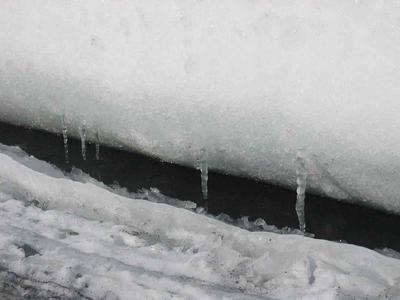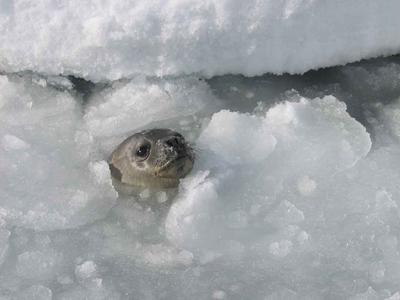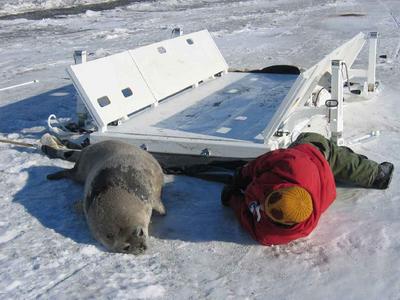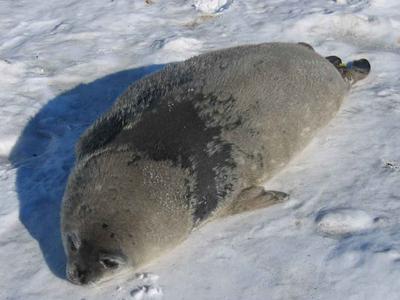14 November, 2003
In a place where winter lasts so long, the rest of the seasons seem
to move along at a rather rapid pace. Other than the daily variation
in temperature and wind, each day has some reminder that we are not
much more than a month away from the summer solstice. For those of
you in the middle latitudes of the northern hemisphere, think about
late May; the sun rises higher in the sky each morning and stays
longer in the evening, birds are returning from their winter
migration, leaves are appearing on the trees, spring wildflowers are
exhibiting their colors, and rivers are rising with meltwater from
high alpine snows. Change happens rapidly and suddenly, it's summer.
The spring/summer transition seems much more subtle here in
Antarctica. The sun, which last set in late October, just marches
across the sky a little higher each day and night and won't dip below
the horizon at McMurdo until February 20th. Besides burning our faces
a little darker brown each day, the sun plays an important role in
the subtle shift from spring to summer. It's certainly warmer now
than it was when we first moved out here to our camp at Big
Razorback. It hasn't been below -18C (about 0F) for a couple of
weeks. High temperatures have been around -7 to -5C at camp and are
probably much higher in some of the places we visit that are
protected from the wind.
How does this affect the ice? There are new melt pools on top of the
ice near some of the cracks. In addition, some of the more prominent
tidal cracks are getting wider, while new smaller cracks are
appearing near some of the seal colonies that we visit regularly.
The water we see in some of the cracks or in the seal swimming holes
no longer looks like a giant slushy. I even noticed icicles hanging
from some of the crack edges today-to get icicles you need to have
melting, so it must have been over 0C along those cracks. It's a
good time to pay attention when cruising across the ice since the
crack you saw today might be quite different the next time out.
What are the seals doing? Well, the pups are getting fat. Their
days are spent lounging next to their mothers drinking milk with a
fat content of 60%. Think about sitting in front of the TV with an
endless supply of pizza and Twinkies and very little exercise. The
pounds add up. Today we weighed a seal pup that was 92kg. Since
most weigh around 30 to 35 kg at birth, this one has definitely put
on some weight. Some of the pups are swimming with their mothers, or
at least lolling about in the holes and taking short dips. The
mothers are losing weight, regaining just a bit of their former
svelte seal selves. They will not eat until their pups are weaned,
so the pup's weight gain is their weight loss. Many of the mothers
are now swimming while their pups continue to lounge on the ice. In
addition, the pups are losing their original furry coats and
replacing them with a coat of short seal fur now that they have
developed a substantial layer of blubber for insulation. Many of the
pups look like mini-seals now, instead of awkward furry babies.
Our Skua population has increased from the first few stragglers.
They are a constant part of the seal colonies, feasting on dead seals
or on the bloody afterbirth that remains when the seal pups are born.
The warm temperatures thaw these Skua snacks, so they can eat them.
Until now much of their food was too frozen to access. We also see
the occasional flightless bird, when stray Adelie Penguins cruise in
from Cape Royds. We're not sure where they're heading, but they
definitely keep moving along!
This is not to say that we are all running around here in our
t-shirts basking in the warm almost-summer sunshine. The transition
from spring to summer in Antarctica seems as fickle as that same
transition at home. While you can have a long streak of beautiful
warm days, there are always a few cold and blustery ones thrown in to
remind you that it is not quite summer yet. I've been reminded of
this on a few mornings when I step outside anticipating the Antarctic
equivalent of balmy, only to be greeted by a chilling wind coming
straight from the South Pole. Oh well, just keep pulling on all
those nice layers of long underwear!
Daily Haiku:
Twenty-four hour sun
Its rays penetrate the ice
Thawing and changing

Icicles form on the bottom of one of the sea ice cracks.

This pup is getting a slushy swimming lesson from its mother.

Guess who weighs more--the pup or the researcher? This pup weighed 92 kg--definitely more than the researcher.

This pup is molting, shedding its long baby fur and growing a sleek coat of short adult seal fur. You can see the dark patch of adult fur across its mid-section.
Contact the TEA in the field at
.
If you cannot connect through your browser, copy the
TEA's e-mail address in the "To:" line of
your favorite e-mail package.
|
